Emission Features and Structure of an Electron Beam versus Gas Pressure and Magnetic Field in a Cold-Cathode Coaxial Diode
Abstract
1. Introduction
2. Experimental Setup and Diagnostic Methods
3. Results, Comments, and Interpretation
3.1. General Remarks
3.2. Azimuthal Structure of the RAE Beam and Its Emission Stability
3.3. Transition from the EEE Emission to the Electron Runaway in a Gas
3.4. Estimation for the Threshold Pressure between the EEE and RAE Generation Modes
4. Conclusions
Author Contributions
Funding
Data Availability Statement
Acknowledgments
Conflicts of Interest
References
- Gold, S.H.; Nusinovich, G.S. Review of high-power microwave source research. Rev. Sci. Instrum. 1997, 68, 3945–3974. [Google Scholar] [CrossRef]
- Benford, J.; Swegle, J.A.; Schamiloglu, E. High Power Microwaves, 3rd ed.; CRC Press: Boca Raton, FL, USA, 2015. [Google Scholar]
- Afanas’ev, K.V.; Bykov, N.M.; Gubanov, V.P.; El’chaninov, A.A.; Klimov, A.I.; Korovin, S.D.; Rostov, V.V.; Stepchenko, A.S. A high-power periodic nanosecond pulse source of coherent 8-cm electromagnetic radiation. Tech. Phys. Lett. 2006, 32, 925–927. [Google Scholar] [CrossRef]
- Grishin, D.M.; Lyubutin, S.K.; Mesyats, G.A.; Rostov, V.V.; Rukin, S.N.; Slovikovsky, B.G.; Timoshenkov, S.P.; Ul’maskulov, M.R.; Sharypov, K.A.; Shpak, V.G.; et al. Generation of Gigawatt 10-GHz Pulses with Stable Phase. Tech. Phys. Lett. 2008, 34, 822–824. [Google Scholar] [CrossRef]
- Rostov, V.V.; Gunin, A.V.; Romanchenko, I.V.; Pedos, M.S.; Rukin, S.N.; Sharypov, K.A.; Shunailov, S.A.; Shpak, V.G.; Ul’masculov, M.R.; Yalandin, M.I. Relativistic Ka-band backward-wave oscillators with stable phase. Phys. Plasmas 2017, 24, 063111. [Google Scholar] [CrossRef]
- Pengvanich, P.; Lau, Y.Y.; Luginsland, J.W.; Gilgenbach, R.M.; Cruz, E.; Schamiloglu, E. Effects of frequency chirp on magnetron injection locking. Phys. Plasmas. 2008, 15, 073110. [Google Scholar] [CrossRef]
- Andreev, D.; Kuskov, A.; Schamiloglu, E. Review of the relativistic magnetron. Matter Radiat. Extremes 2019, 4, 067201. [Google Scholar] [CrossRef]
- Wu, Y.; Li, Z.H.; Xu, Z. Experimental study of an X-band phase-locked relativistic backward wave oscillator. Phys. Plasmas 2015, 22, 113102. [Google Scholar] [CrossRef]
- Teng, Y.; Song, W.; Sun, J.; Xiao, R.Z.; Song, Z.; Zhang, L.; Zhang, Z.; Zhang, L.; Zhang, Y.; Li, J.; et al. Phase locking of high power relativistic backward wave oscillator using priming effect. J. Appl. Phys. 2012, 111, 043303. [Google Scholar] [CrossRef]
- Nusinovich, G.S.; Sinitsyn, O.V.; Rogers, J.; Shkvarunets, A.G.; Carmel, Y. Phase locking in backward-wave oscillators with strong end reflections. Phys. Plasmas. 2007, 14, 053109. [Google Scholar] [CrossRef]
- Xiao, R.Z.; Deng, Y.; Shi, Y.; Yang, D. Phase stabilization of a relativistic backward wave oscillator by controlling the cathode characteristics for a slowly rising voltage pulse. J. Appl. Phys. 2019, 125, 173302. [Google Scholar] [CrossRef]
- Mesyats, G.A.; Ginzburg, N.S.; Golovanov, A.A.; Denisov, G.G.; Romanchenko, I.V.; Rostov, V.V.; Sharypov, K.A.; Shpak, V.G.; Shunailov, S.A.; Ulmaskulov, M.R.; et al. Phase-Imposing Initiation of Cherenkov Superradiance Emission by an Ultra-Short Seed Microwave Pulse. Phys. Rev. Lett. 2017, 118, 264801. [Google Scholar] [CrossRef]
- Bakunin, V.L.; Denisov, G.G.; Novozhilova, Y.V. Phase Locking of a Gyrotron with Low-Frequency Voltage and Current Fluctuations by an External Monochromatic Signal. Radiophys. Quantum Electron. 2020, 63, 392–402. [Google Scholar] [CrossRef]
- Bakunin, V.L.; Denisov, G.G.; Novozhilova, Y.V. Frequency and phase stabilization of a multimode gyrotron with megawatt power by an external signal. Tech. Phys. Lett. 2014, 40, 382–385. [Google Scholar] [CrossRef]
- Song, W.; Sun, J.; Shao, H.; Xiao, R.Z.; Chen, C.H.; Liu, G.Z. Inducing phase locking of multiple oscillators beyond the Adler’s condition. J. Appl. Phys. 2012, 111, 023302. [Google Scholar] [CrossRef]
- Shunailov, S.A.; Mesyats, G.A.; Romanchenko, I.V.; Rostov, V.V.; Sadykova, A.G.; Sharypov, K.A.; Shpak, V.G.; Ulmasculov, M.R.; Yalandin, M.I. Electromagnetic noise of a nanosecond magnetized high-current electron beam. J. Appl. Phys. 2019, 126, 164504. [Google Scholar] [CrossRef]
- Abubakirov, E.B.; Denisenko, A.N.; Konyushkov, A.P.; Soluyanov, E.I.; Yastrebov, V.V. Observation of Large-Scale Shot Noise in a High-Current Electron Beam. Tech. Phys. Lett. 2018, 44, 857–859. [Google Scholar] [CrossRef]
- Korovin, S.D.; Litvinov, E.A.; Mesyats, G.A.; Murzakaev, A.M.; Rostov, V.V.; Shpak, V.G.; Shunailov, S.A.; Yalandin, M.I. Experimental investigation of graphite explosive-emission cathodes operating in a periodic pulse regime. Tech. Phys. Lett. 2004, 30, 813–816. [Google Scholar] [CrossRef]
- Ginzburg, N.S.; Sergeev, A.S.; Zotova, I.V.; Novozhilova, Y.V.; Peskov, N.Y.; Konoplev, I.V.; Phelps, A.D.R.; Cross, A.W.; Cooke, S.J.; Aitken, P.; et al. Experimental observation of superradiance in millimeter-wave band. Nucl. Instrum. Methods Phys. Res. A 1997, 393, 352–355. [Google Scholar] [CrossRef]
- Grishin, D.M.; Gubanov, V.P.; Korovin, S.D.; Lyubutin, S.K.; Mesyats, G.A.; Nikiforov, A.V.; Rostov, V.V.; Rukin, S.N.; Slovikovskii, B.G.; Ul’maskulov, M. R et al. High-power subnanosecond 38-GHz microwave pulses generated at a repetition rate of up to 3.5 kHz. Tech. Phys. Lett. 2002, 28, 806–809. [Google Scholar] [CrossRef]
- Eltchaninov, A.A.; Korovin, S.D.; Mesyats, G.A.; Pegel, I.V.; Rostov, V.V.; Shpak, V.G.; Yalandin, M.I. Review of Studies of Superradiative Microwave Generation in X-Band and Ka-Band Relativistic BWO’s. IEEE Trans. Plasma Sci. 2004, 32, 1093–1099. [Google Scholar] [CrossRef]
- Rostov, V.V.; Romanchenko, I.V.; Pedos, M.S.; Rukin, S.N.; Sharypov, K.A.; Shpak, V.G.; Shunailov, S.A.; Ul’masculov, M.R.; Yalandin, M.I. Superradiant Ka-band Cherenkov oscillator with 2-GW peak power. Phys. Plasmas 2016, 23, 093103. [Google Scholar] [CrossRef]
- Rostov, V.V.; El’chaninov, A.A.; Klimov, A.I.; Konev, V.Y.; Romanchenko, I.V.; Sharypov, K.A.; Shunailov, S.A.; Ul’maskulov, M.R.; Yalandin, M.I. Phase Control in Parallel Channels of Shock-Excited Microwave Nanosecond Oscillators. IEEE Trans. Plasma Sci. 2013, 41, 2735–2741. [Google Scholar] [CrossRef]
- Rostov, V.V.; Elchaninov, A.A.; Romanchenko, I.V.; Shunailov, S.A.; Ul’maskulov, M.R.; Sharypov, K.A.; Shpak, V.G.; Rukin, S.N.; Yalandin, M.I. Two-Channel Generator of the 8-mm Wavelength Range for Radiation with Subgigawatt Power Level Pulses. Radiophys. Quantum Electron. 2014, 56, 475–493. [Google Scholar] [CrossRef]
- Xiao, R.; Wang, Y.; Deng, Y.; Bai, X.; Song, Z. Particle-in-Cell Demonstration of the Effect of Voltage Rise Time on Phase Synchronization in Two Parallel Relativistic Backward-Wave Oscillators. IEEE. Trans. Electron. Devices 2016, 63, 1317–1321. [Google Scholar] [CrossRef]
- Xiao, R.Z.; Deng, Y.Q.; Chen, C.H.; Shi, Y.C.; Sun, J. Generation of powerful microwave pulses by channel power summation of two X-band phase-locked relativistic backward wave oscillators. Phys. Plasmas 2018, 25, 033109. [Google Scholar] [CrossRef]
- Vikharev, A.; Ginzburg, N.; Kuzikov, S.; Zotova, I.; Yalandin, M. Generation of Powerful Subterahertz Superradiance Pulses for High-Gradient Acceleration of Charged Particles. EPJ Web Conf. 2018, 195, 01023. [Google Scholar] [CrossRef][Green Version]
- Danilov, Y.; Ginzburg, N.; Zotova, I.; Yalandin, M. The use of microwave superradiance pulses for electron high-gradient acceleration in cylindrical waveguide with dielectric insertion. Pis’ma Zh. Tekh. Fiz. 2021, 47, 27–30. [Google Scholar] [CrossRef]
- Ginzburg, N.S.; Malkin, A.M.; Sergeev, A.S.; Zheleznov, I.V.; Zotova, I.V.; Zaslavsky, V.Y.; Boltachev, G.S.; Sharypov, K.A.; Shunailov, S.A.; Ul’masculov, M.R.; et al. Generation of Sub-Terahertz Superradiance Pulses Based on Excitation of a Surface Wave by Relativistic Electron Bunches Moving in Oversized Corrugated Waveguides. Phys. Rev. Lett. 2016, 117, 204801. [Google Scholar] [CrossRef]
- Ginzburg, N.S.; Zaslavsky, V.Y.; Malkin, A.M.; Sergeev, A.S.; Zotova, I.V.; Sharypov, K.A.; Shunailov, S.A.; Shpak, V.G.; Ul’masculov, M.R.; Yalandin, M.I. Generation of intense spatially coherent superradiant pulses in strongly oversized 2D periodical surface-wave structure. Appl. Phys. Lett. 2020, 127, 183505. [Google Scholar] [CrossRef]
- Rostov, V.V.; Gunin, A.V.; Tsygankov, R.V.; Romanchenko, I.V.; Yalandin, M.I. Two-wave Cherenkov Oscillator with Moderately Oversized Slow Wave Structure. IEEE Trans. Plasma Sci. 2018, 46, 33–42. [Google Scholar] [CrossRef]
- Li, S.F.; Duan, Z.Y.; Huang, H.; Chen, Z.F.; Liu, Z.B.; He, H.; Wang, Z.L.; Gong, Y.B. Oversized coaxial relativistic extended interaction oscillator with gigawatt-level output at Ka-band. Phys. Plasmas 2019, 26, 043107. [Google Scholar] [CrossRef]
- Teng, Y.; Cao, Y.; Song, Z.; Ye, H.; Shi, Y.; Chen, C.; Sun, J. A Kaband TM02 mode relativistic backward wave oscillator with cascaded resonators. Phys. Plasmas 2014, 21, 123108. [Google Scholar] [CrossRef]
- Belomytsev, S.Y.; Korovin, S.D.; Mesyats, G.A. Shielding effect in the high-current diodes. Pis’ma Zh. Tekh. Fiz. 1980, 6, 1089–1092. [Google Scholar]
- Dreicer, H. Electron and ion runaway in a fully ionized gas: II. Phys. Rev. 1960, 117, 329–342. [Google Scholar] [CrossRef]
- Gurevich, A.V. On the theory of runaway electrons. Sov. Phys. JETP 1961, 12, 904–912. [Google Scholar]
- Stankevich, Y.L.; Kalinin, V.G. Fast electrons and X-radiation in the initial stage of pulse spark discharge development in air. Dokl. Akad. Nauk SSSR 1967, 177, 72–73. [Google Scholar]
- Babich, L.P.; Loiko, T.V.; Tsukerman, V.A. High-voltage nanosecond discharge in a dense gas at a high overvoltage with runaway electrons. Sov. Phys. Usp. 1990, 33, 521–540. [Google Scholar] [CrossRef]
- Babich, L.P.; Becker, K.H.; Loiko, T.V. Luminescence From Minerals Excited by Subnanosecond Pulses of Runaway Electrons Generated in an Atmospheric-Pressure High-Voltage Discharge in Air. IEEE Trans. Plasma Sci. 2009, 37, 2261–2264. [Google Scholar] [CrossRef]
- Shao, T.; Zhang, C.; Niu, Z.; Yan, P.; Tarasenko, V.F.; Baksht, E.K.; Burahenko, A.G.; Shut’ko, Y.V. Diffuse discharge, runaway electron, and x-ray in atmospheric pressure air in an inhomogeneous electrical field in repetitive pulsed modes. Appl. Phys. Lett. 2011, 98, 021503. [Google Scholar] [CrossRef]
- Tarasenko, V.F.; Shpak, V.G.; Shunailov, S.A.; Yalandin, M.I.; Orlovskii, V.M.; Alekseev, S.B. Subnanosecond electron beams formed in a gas-filled diode. Tech. Phys. Lett. 2003, 29, 879–881. [Google Scholar] [CrossRef]
- Mesyats, G.A.; Yalandin, M.I.; Sharypov, K.A.; Shpak, V.G.; Shunailov, S.A. Generation of a Picosecond Runaway Electron Beam in a Gas Gap with a Nonuniform Field. IEEE Trans. Plasma Sci. 2008, 36, 2497–2504. [Google Scholar] [CrossRef]
- Mesyats, G.A.; Yalandin, M.I. On the Nature of Picosecond Runaway Electron Beams in Air. IEEE Trans. Plasma Sci. 2009, 37, 785–789. [Google Scholar] [CrossRef]
- Tarasenko, V.F.; Rybka, D.V.; Burachenko, A.G.; Lomaev, M.I.; Balzovsky, E.V. Measurement of extreme-short current pulse duration of runaway electron beam in atmospheric pressure air. Rev. Sci. Instrum. 2012, 83, 086106. [Google Scholar] [CrossRef]
- Yatom, S.; Shlapakovski, A.; Beilin, L.; Stambulchik, E.; Tskhai, S.; Krasik, Y.E. Recent studies on nanosecond-timescale pressurized gas discharges. Plasma Sources Sci. Technol. 2016, 25, 064001. [Google Scholar] [CrossRef]
- Gurevich, A.V.; Mesyats, G.A.; Zybin, K.P.; Yalandin, M.I.; Reutova, A.G.; Shpak, V.G.; Shunailov, S.A. Observation of the Avalanche of Runaway Electrons in Air in a Strong Electric Field. Phys. Rev. Lett. 2012, 109, 085002. [Google Scholar] [CrossRef]
- Korolev, Y.D.; Mesyats, G.A. Physics of Pulsed Breakdown in Gases; Nauka: Moscow, Russia, 1991. [Google Scholar]
- Tarasova, L.V.; Khudyakova, L.N.; Loiko, T.V.; Tsukerman, V.A. 1974 Runaway electrons and X-rays of nanosecond discharges in gases at pressures of 0.1-760 Torr. Sov. J. Tech. Phys. 1974, 44, 564–568. [Google Scholar]
- Mesyats, G.A. Explosion Electron Emission; URO-Press: Yekaterinburg, Russia, 1998. [Google Scholar]
- Oreshkin, E.V.; Barengolts, S.A.; Chaikovsky, S.A.; Oreshkin, V.I. Simulation of a runaway electron avalanche devel-oping in an atmospheric pressure air discharge. Phys. Plasmas 2015, 22, 123505. [Google Scholar] [CrossRef]
- Baranov, V.F. Dozimetry of Eletronic Radiation; Atomizdat: Moscow, Russia, 1974. [Google Scholar]
- Yalandin, M.I.; Reutova, A.G.; Sharypov, K.A.; Shpak, V.G.; Shunailov, S.A.; UImasculov, M.R.; Rostov, V.V.; Mesyats, G.A. Stability of Injection of a Subnanosecond High-Current Electron Beam and Dynamic Effects Within Its Risetime. IEEE Trans. Plasma Sci. 2010, 38, 2559–2564. [Google Scholar] [CrossRef]
- Sharypov, K.A.; Ul’masculov, M.R.; Shpak, V.G.; Shunailov, S.A.; Yalandin, M.I.; Mesyats, G.A.; Rostov, V.V.; Kolomiets, M.D. Current waveform reconstruction from an explosively emissive cathode at a subnanosecond voltage front. Rev. Sci. Instrum. 2014, 85, 125104. [Google Scholar] [CrossRef] [PubMed]
- Shpak, V.G.; Shunailov, S.A.; Yalandin, M.I.; Dyadkov, A.N. The RADAN SEF-303A, a small high-current pulsed power supply. Instrum. Exp. Tech. 1993, 36, 106–111. [Google Scholar]
- Yalandin, M.I.; Lyubutin, S.K.; Oulmascoulov, M.R.; Rukin, S.N.; Shpak, V.G.; Shunailov, S.A.; Slovikovsky, B.G. High peak power and high average power subnanosecond modulator operating at a repetition frequency of 3.5 kHz. IEEE Trans. Plasma Sci. 2002, 30, 1700–1704. [Google Scholar] [CrossRef]
- Mesyats, G.A.; Shpak, V.G.; Shunailov, S.A.; Yalandin, M.I. Desk-top subnanosecond pulser research, development and applications. In Proceedings of the SPIE International Symposium: Intense Microwave Pulses II, Los Angeles, CA, USA, 24–26 January 1994; Volume 2154, pp. 262–268. [Google Scholar] [CrossRef]
- Juttner, B.; Putchkarjov, V.F.; Rohrbech, W. Behavior of micropoints during high voltage vacuum discharges. In Proceedings of the VII Int. Symp. on Discharges and Electrical Insulation in Vacuum, Novosibirsk, USSR, August 1976; pp. 189–192. [Google Scholar]
- Yalandin, M.I.; Mesyats, G.A.; Rostov, V.V.; Sharypov, K.A.; Shpak, V.G.; Shunailov, S.A.; Ulmasculov, M.R. Suppression of shunting current in a magnetically insulated coaxial vacuum diode. Appl. Phys. Lett. 2015, 106, 233504. [Google Scholar] [CrossRef]
- Zubarev, N.M.; Yalandin, M.I.; Mesyats, G.A.; Barengolts, S.A.; Sadykova, A.G.; Sharypov, K.A.; Shpak, V.G.; Shunailov, S.A.; Zubareva, O.V. Experimental and theoretical investigations of the conditions for the generation of runaway electrons in a gas diode with a strongly nonuniform electric field. J. Phys. D Appl. Phys. 2018, 51, 284003. [Google Scholar] [CrossRef]
- Levko, D.; Yatom, S.; Krasik, Y.E. Particle-in-cell modeling of the nanosecond field emission driven discharge in pressurized hydrogen. J. Appl. Phys. 2018, 123, 083303. [Google Scholar] [CrossRef]
- Naidis, G.V.; Tarasenko, V.F.; Babaeva, N.Y.; Lomaev, M.I. Subnanosecond breakdown in high-pressure gases. Plasma Sources Sci. Technol. 2018, 27, 013001. [Google Scholar] [CrossRef]
- Beloplotov, D.V.; Lomaev, M.I.; Sorokin, D.A.; Tarasenko, V.F. Ionization Waves During the Subnanosecond Breakdown Initiated by Runaway Electrons in High-Pressure Nitrogen and Air. Russ. Physics, J. 2017, 60, 1308–1313. [Google Scholar] [CrossRef]
- Kozhevnikov, V.Y.; Kozyrev, A.V.; Semeniuk, N.S. Physical kinetics of electrons in a high-voltage pulsed high-pressure discharge with cylindrical geometry. Russ. Phys. J. 2017, 60, 1425–1436. [Google Scholar] [CrossRef]
- Mesyats, G.A.; Yalandin, M.I. Nanosecond volume discharge in air initiated by a picosecond runaway electron beam. Phys. Usp. 2019, 62, 699–703. [Google Scholar] [CrossRef]
- Sharypov, K.A.; Shunailov, S.A.; Yalandin, M.I.; Zubarev, N.M. Reflectometry of Picosecond Emission and Discharge Processes in a Gas-Filled High-Voltage Coaxial Line. IEEE Trans. Plasma Sci. 2021, 49, 2516–2523. [Google Scholar] [CrossRef]
- Elinson, M.I.; Vasil’ev, G.F. Autoelectronic Emission; Fizmatgiz: Moscow, Russia, 1958. [Google Scholar]
- Batrakov, A.V.; Proskurovsky, D.I.; Popov, S.A. Observation of the field emission from the melting zone occurring just before explosive electron emission. IEEE Trans. Dielectr. Electr. Insul. 1999, 6, 410–417. [Google Scholar] [CrossRef]
- Batrakov, A.V.; Pegel, I.V.; Proskurovskii, D.I. Limitation of the field emission current density by the space charge of the emitted electrons. Tech. Phys. Lett. 1999, 25, 454–455. [Google Scholar] [CrossRef]
- Belomyttsev, S.Y.; Romanchenko, I.V.; Ryzhov, V.V.; Shklyaev, V.A. Initial stage of gas discharge in an inhomogeneous electric field. Tech. Phys. Lett. 2008, 34, 367–369. [Google Scholar] [CrossRef]
- Mesyats, G.A.; Yalandin, M.I.; Zubarev, N.M.; Sadykova, A.G.; Sharypov, K.A.; Shpak, V.G.; Shunailov, S.A.; Ulmaskulov, M.R.; Zubareva, O.V.; Kozyrev, A.V.; et al. How short is the runaway electron flow in an air electrode gap? Appl. Phys. Lett. 2020, 116, 063501. [Google Scholar] [CrossRef]
- Batrakov, A.V.; Pegel, I.V.; Proskurovsky, D.I. On the screening of the electric field at the cathode surface by an electron space charge at intense field emission. IEEE Trans. Dielectr. Electr. Insul. 1999, 6, 436–440. [Google Scholar] [CrossRef]
- Tiunov, M.A.; Fomel, B.M.; Yakovlev, V.P. SAM—An Interactive Code for Electron Gun Evaluation; Tech. Rep. INP-89-159; INP: Novosibirsk, Russia, 1989. [Google Scholar]
- Korovin, S.D.; Pegel, I.V. Structure of a high-current relativistic electron beam formed in a coaxial magnetically insulated diode with an edge cathode. Zh. Tekh. Fisiki 1992, 62, 139–145. [Google Scholar]
- Belomyttsev, S.Y.; Rostov, V.V.; Romanchenko, I.V.; Shunailov, S.A.; Kolomiets, M.D.; Mesyats, G.A.; Sharypov, K.A.; Shpak, V.G.; Ulmaskulov, M.R.; Yalandin, M.I. Magnetically Insulated Coaxial Vacuum Diode with Partial Space-Charge-Limited Explosive Emission from Edge-Type Cathode. J. Appl. Phys. 2016, 119, 023304. [Google Scholar] [CrossRef]
- Belomyttsev, S.Y.; Korovin, S.D.; Pegel, I.V. Effect of the expanding explosive-emission centers plasma on the impedance of a high-current diode. IEEE Trans. Plasma Sci. 1999, 27, 1572–1577. [Google Scholar] [CrossRef]
- Askar’yan, G.A. New possibilities of particle acceleration to high energies. Proc. P.N. Lebedev Phys. Inst. (USSR) 1973, 66, 66–72. [Google Scholar]
- Mesyats, G.A.; Romanchenko, I.V.; Rostov, V.V.; Sadykova, A.G.; Sharypov, K.A.; Shpak, V.G.; Shunailov, S.A.; Ul’masculov, M.R.; Yalandin, M.I. Effect of a submicrosecond-advanced voltage pulse on the formation of a high-current electron beam in a magnetically-insulated coaxial diode. Phys. Plasmas 2018, 25, 103118. [Google Scholar] [CrossRef]
- Sadykova, A.G.; Shunailov, S.A.; Yalandin, M.I.; Gurevich, A.V.; Zybin, K.P.; Sadykov, A.F.; Kolomiets, M.D. Air gap breakdown on runaway electrons. Russ. Phys. J. 2014, 57, 269–273. [Google Scholar]
- Mesyats, G.A.; Pedos, M.S.; Rukin, S.N.; Rostov, V.V.; Romanchenko, I.V.; Sadykova, A.G.; Sharypov, K.A.; Shpak, V.G.; Shunailov, S.A.; Ul’masculov, M.R. Formation of 1.4 MeV runaway electron flows in air using a solid-state generator with 10 MV/ns voltage rise rate. Appl. Phys. Lett. 2018, 112, 163501. [Google Scholar] [CrossRef]
- Zubarev, N.M.; Kozhevnikov, V.Y.; Kozyrev, A.V.; Mesyats, G.A.; Semeniuk, N.S.; Sharypov, K.A.; Shunailov, S.A.; Yalandin, M.I. Mechanism and dynamics of picosecond radial breakdown of a gas-filled coaxial line. Plasma Sources Sci. Technol. 2020, 29, 125008. [Google Scholar] [CrossRef]
- Peterson, L.R.; Green, A.E.S. The relation between ionization yields, cross sections and loss functions. J. Phys. B At. Mol. Phys. 1968, 1, 1131–1140. [Google Scholar] [CrossRef]
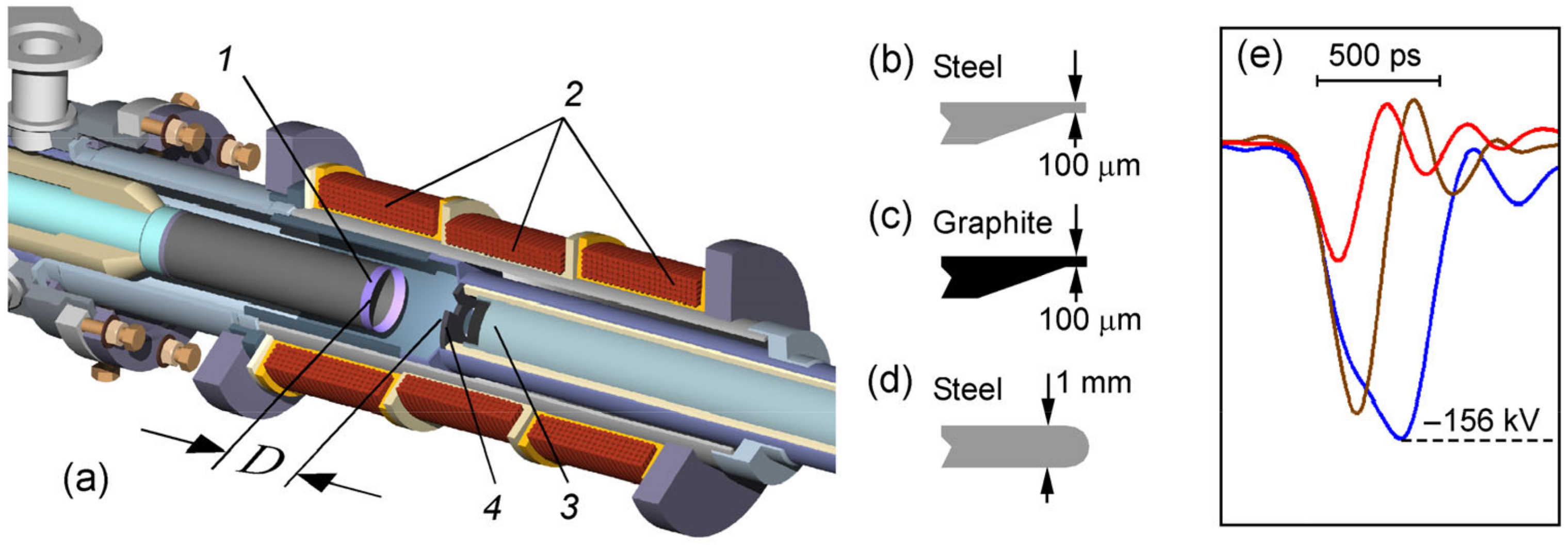

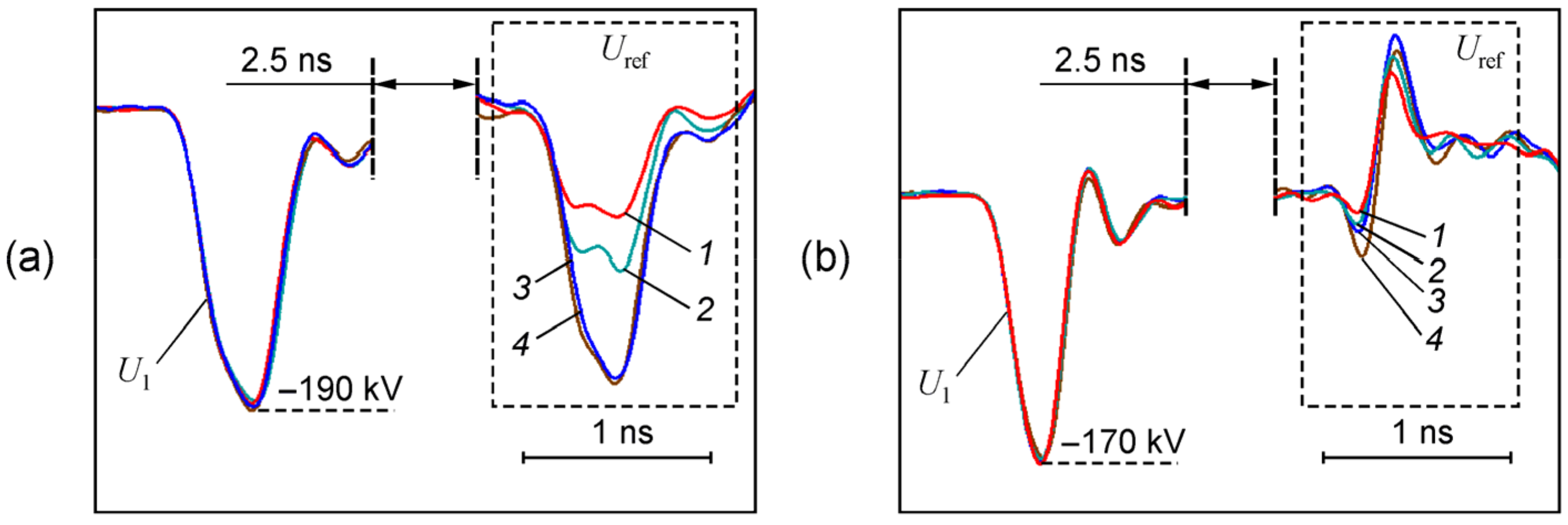
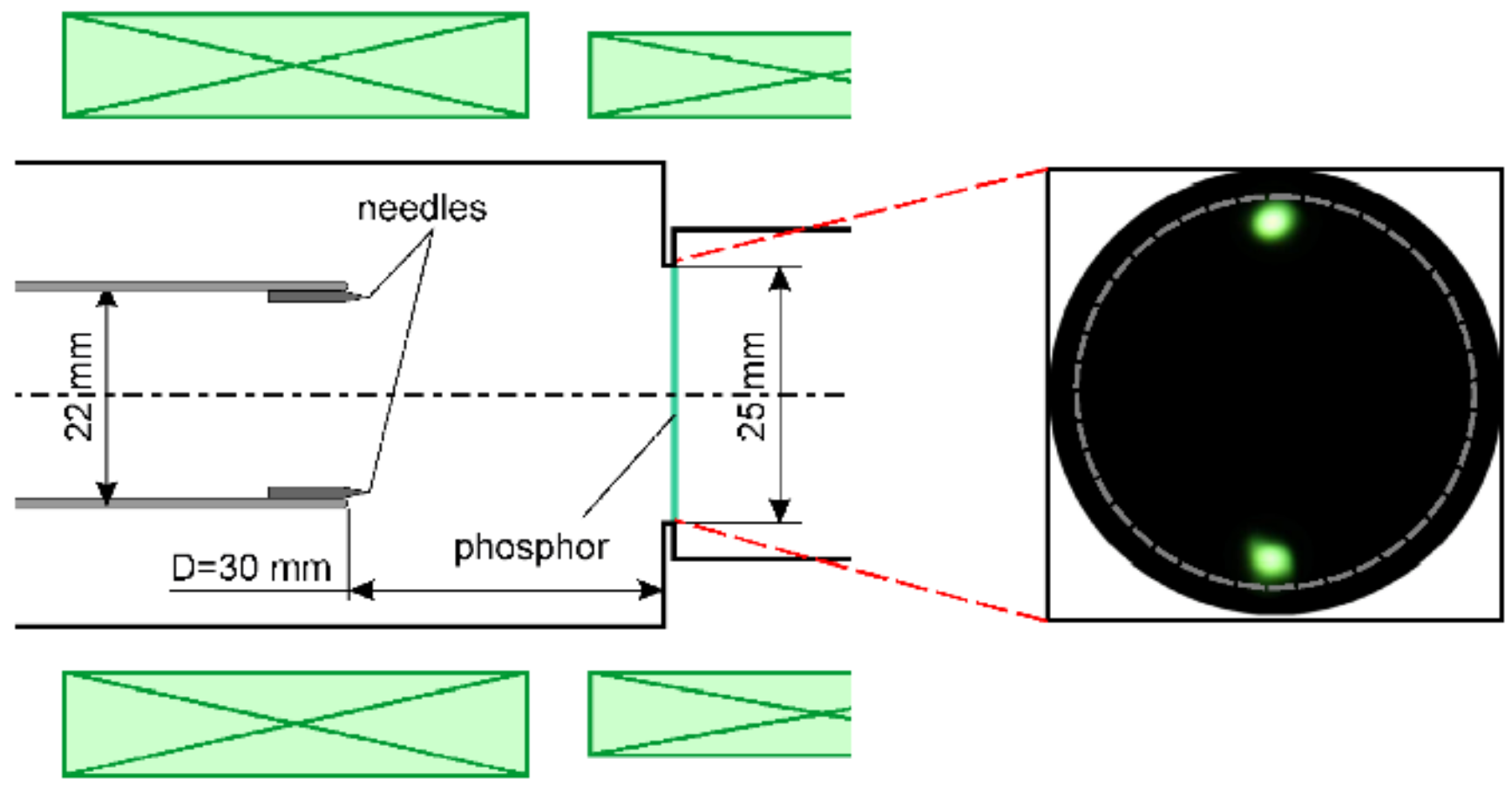




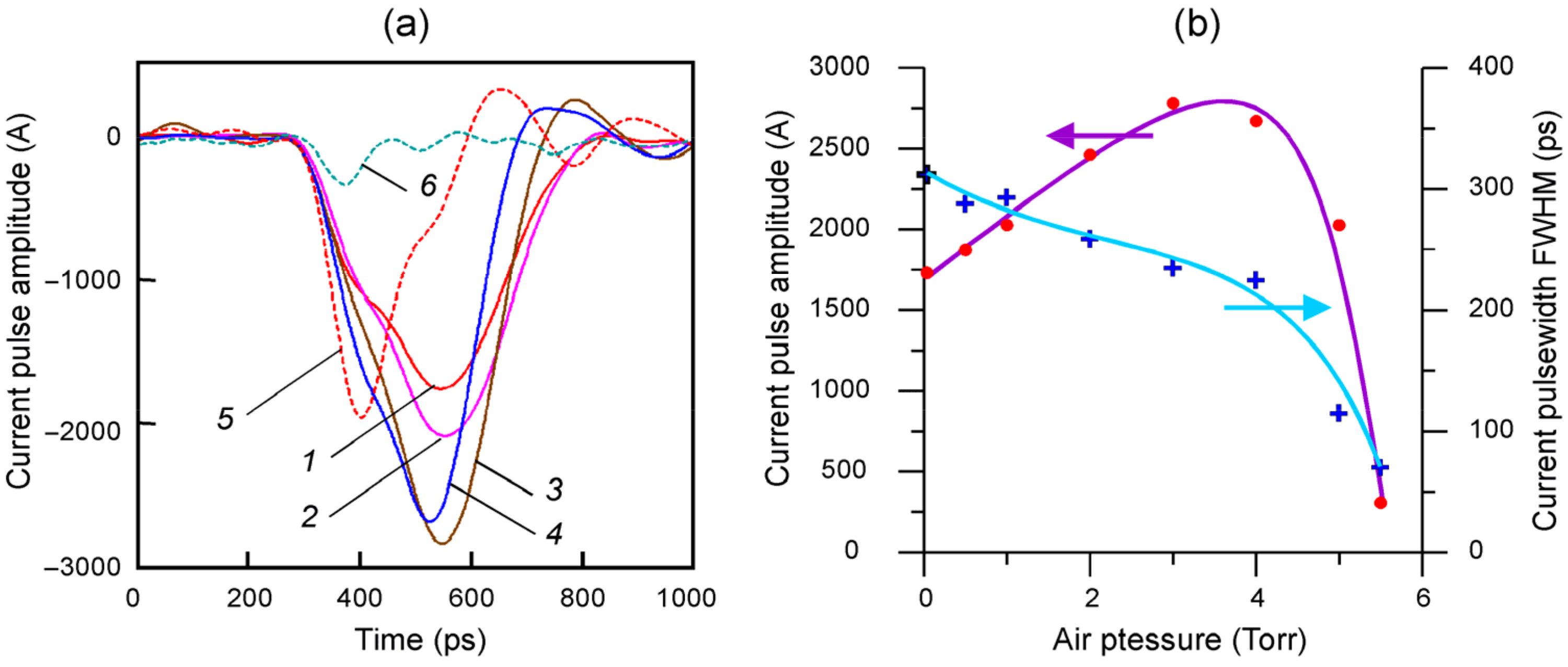
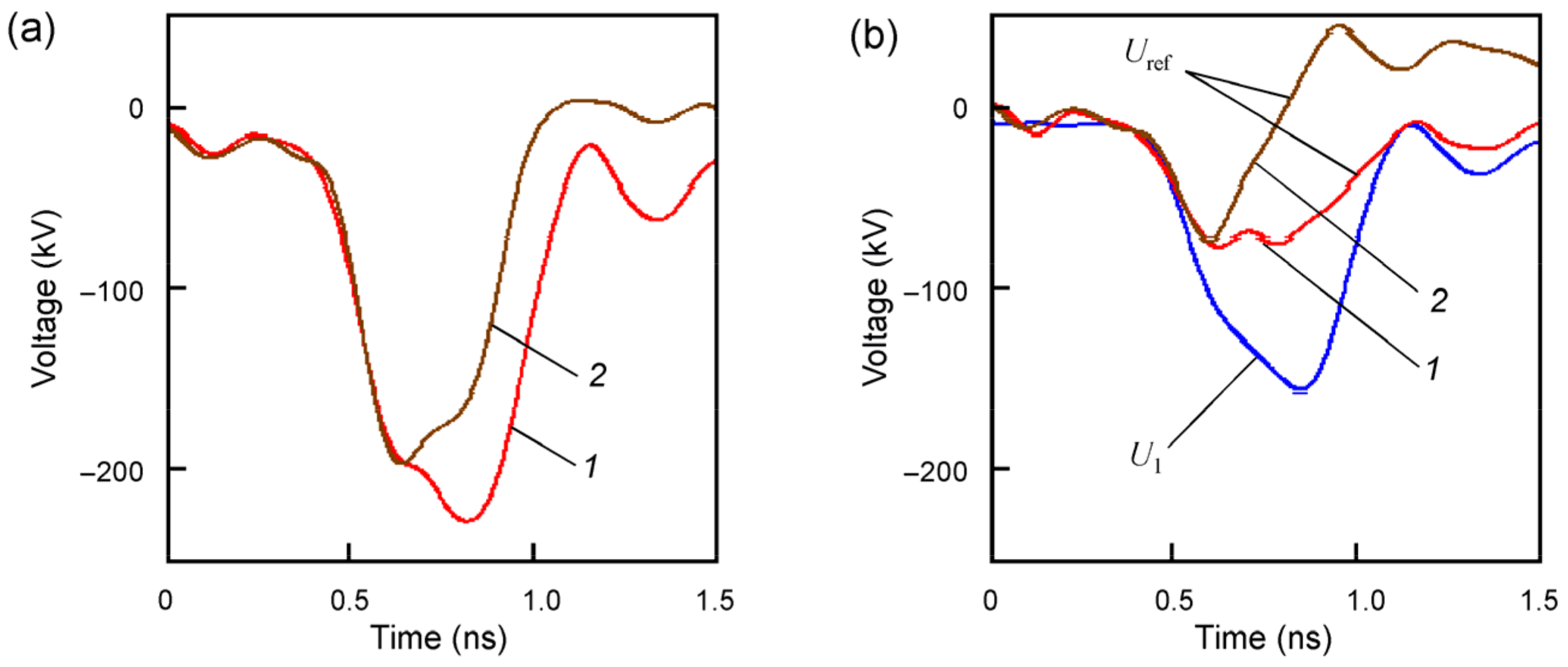
Publisher’s Note: MDPI stays neutral with regard to jurisdictional claims in published maps and institutional affiliations. |
© 2022 by the authors. Licensee MDPI, Basel, Switzerland. This article is an open access article distributed under the terms and conditions of the Creative Commons Attribution (CC BY) license (https://creativecommons.org/licenses/by/4.0/).
Share and Cite
Mesyats, G.; Rostov, V.; Sharypov, K.; Shpak, V.; Shunailov, S.; Yalandin, M.; Zubarev, N. Emission Features and Structure of an Electron Beam versus Gas Pressure and Magnetic Field in a Cold-Cathode Coaxial Diode. Electronics 2022, 11, 248. https://doi.org/10.3390/electronics11020248
Mesyats G, Rostov V, Sharypov K, Shpak V, Shunailov S, Yalandin M, Zubarev N. Emission Features and Structure of an Electron Beam versus Gas Pressure and Magnetic Field in a Cold-Cathode Coaxial Diode. Electronics. 2022; 11(2):248. https://doi.org/10.3390/electronics11020248
Chicago/Turabian StyleMesyats, Gennady, Vladislav Rostov, Konstantin Sharypov, Valery Shpak, Sergey Shunailov, Michael Yalandin, and Nikolay Zubarev. 2022. "Emission Features and Structure of an Electron Beam versus Gas Pressure and Magnetic Field in a Cold-Cathode Coaxial Diode" Electronics 11, no. 2: 248. https://doi.org/10.3390/electronics11020248
APA StyleMesyats, G., Rostov, V., Sharypov, K., Shpak, V., Shunailov, S., Yalandin, M., & Zubarev, N. (2022). Emission Features and Structure of an Electron Beam versus Gas Pressure and Magnetic Field in a Cold-Cathode Coaxial Diode. Electronics, 11(2), 248. https://doi.org/10.3390/electronics11020248






